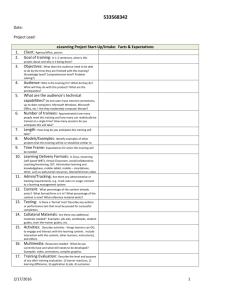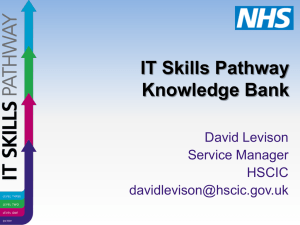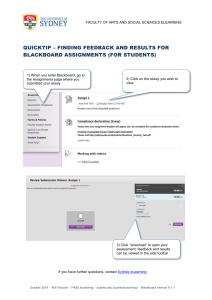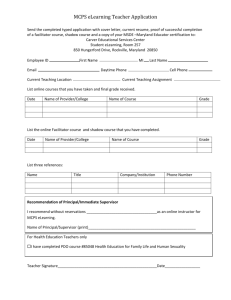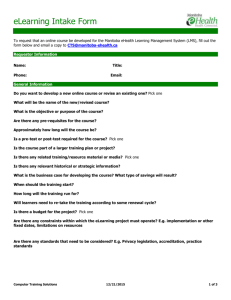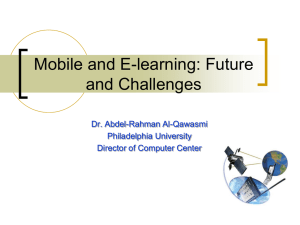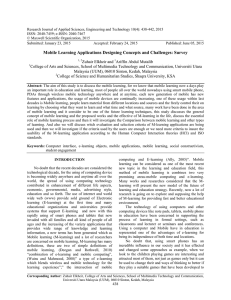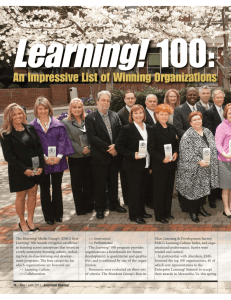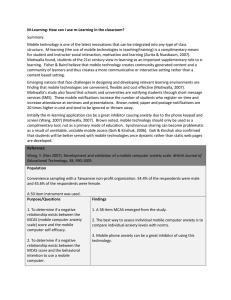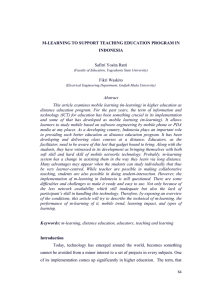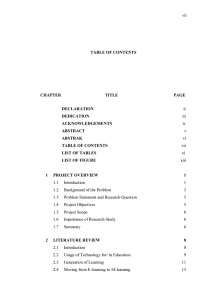A Distributed Learning System - international journal of computer
advertisement
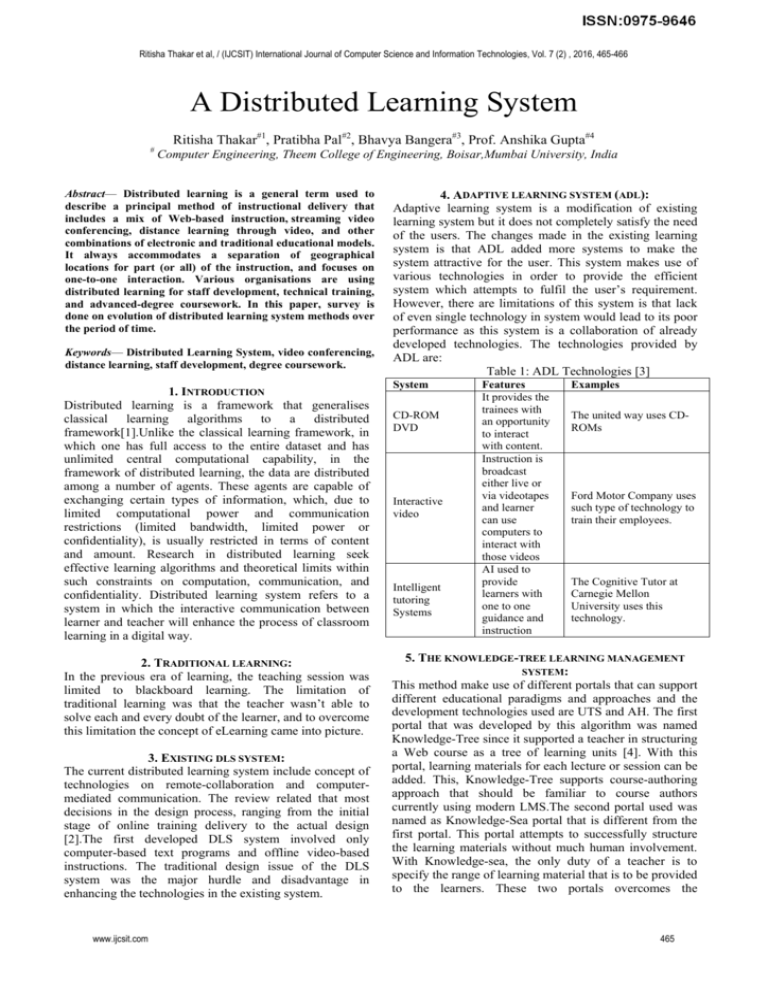
Ritisha Thakar et al, / (IJCSIT) International Journal of Computer Science and Information Technologies, Vol. 7 (2) , 2016, 465-466 A Distributed Learning System Ritisha Thakar#1, Pratibha Pal#2, Bhavya Bangera#3, Prof. Anshika Gupta#4 # Computer Engineering, Theem College of Engineering, Boisar,Mumbai University, India Abstract— Distributed learning is a general term used to describe a principal method of instructional delivery that includes a mix of Web-based instruction, streaming video conferencing, distance learning through video, and other combinations of electronic and traditional educational models. It always accommodates a separation of geographical locations for part (or all) of the instruction, and focuses on one-to-one interaction. Various organisations are using distributed learning for staff development, technical training, and advanced-degree coursework. In this paper, survey is done on evolution of distributed learning system methods over the period of time. Keywords— Distributed Learning System, video conferencing, distance learning, staff development, degree coursework. 1. INTRODUCTION Distributed learning is a framework that generalises classical learning algorithms to a distributed framework[1].Unlike the classical learning framework, in which one has full access to the entire dataset and has unlimited central computational capability, in the framework of distributed learning, the data are distributed among a number of agents. These agents are capable of exchanging certain types of information, which, due to limited computational power and communication restrictions (limited bandwidth, limited power or confidentiality), is usually restricted in terms of content and amount. Research in distributed learning seek effective learning algorithms and theoretical limits within such constraints on computation, communication, and confidentiality. Distributed learning system refers to a system in which the interactive communication between learner and teacher will enhance the process of classroom learning in a digital way. 2. TRADITIONAL LEARNING: In the previous era of learning, the teaching session was limited to blackboard learning. The limitation of traditional learning was that the teacher wasn’t able to solve each and every doubt of the learner, and to overcome this limitation the concept of eLearning came into picture. 3. EXISTING DLS SYSTEM: The current distributed learning system include concept of technologies on remote-collaboration and computermediated communication. The review related that most decisions in the design process, ranging from the initial stage of online training delivery to the actual design [2].The first developed DLS system involved only computer-based text programs and offline video-based instructions. The traditional design issue of the DLS system was the major hurdle and disadvantage in enhancing the technologies in the existing system. www.ijcsit.com 4. ADAPTIVE LEARNING SYSTEM (ADL): Adaptive learning system is a modification of existing learning system but it does not completely satisfy the need of the users. The changes made in the existing learning system is that ADL added more systems to make the system attractive for the user. This system makes use of various technologies in order to provide the efficient system which attempts to fulfil the user’s requirement. However, there are limitations of this system is that lack of even single technology in system would lead to its poor performance as this system is a collaboration of already developed technologies. The technologies provided by ADL are: Table 1: ADL Technologies [3] System CD-ROM DVD Interactive video Intelligent tutoring Systems Features It provides the trainees with an opportunity to interact with content. Instruction is broadcast either live or via videotapes and learner can use computers to interact with those videos AI used to provide learners with one to one guidance and instruction Examples The united way uses CDROMs Ford Motor Company uses such type of technology to train their employees. The Cognitive Tutor at Carnegie Mellon University uses this technology. 5. THE KNOWLEDGE-TREE LEARNING MANAGEMENT SYSTEM: This method make use of different portals that can support different educational paradigms and approaches and the development technologies used are UTS and AH. The first portal that was developed by this algorithm was named Knowledge-Tree since it supported a teacher in structuring a Web course as a tree of learning units [4]. With this portal, learning materials for each lecture or session can be added. This, Knowledge-Tree supports course-authoring approach that should be familiar to course authors currently using modern LMS.The second portal used was named as Knowledge-Sea portal that is different from the first portal. This portal attempts to successfully structure the learning materials without much human involvement. With Knowledge-sea, the only duty of a teacher is to specify the range of learning material that is to be provided to the learners. These two portals overcomes the 465 Ritisha Thakar et al, / (IJCSIT) International Journal of Computer Science and Information Technologies, Vol. 7 (2) , 2016, 465-466 limitations of traditional learning systems as it minimises the human effort for preparing notes but the limitations are wrapped-up to a lesser extent. Limitations: 1) The learning contents are dynamic i.e. they are not stored in the server for later use. 2) The another limitation is that the information used for structuring learning materials are picked up from different sites i.e. this system uses a concept of Reusability. separate versions were created; a basic version and an enhanced version. The basic version of the course was converted to W3C’s extensible HTML 1.0 basic profile as this was proven to be most interoperable across a widerange of mid-end to smartphone device [5]. The second version was developed purely for mobile devices which was based on android using eclipse software. This application proved to be useful to many learners and the survey report says that the M-Learning proves is more efficient as compared to E-Learning [6]. 6. E-LEARNING: E-learning describes the principles of effective multimedia learning using electronic educational technology over the distributed network. ELearning can be done in short chunks of time that can fit around your daily schedule. ELearning is more flexible, mobile, cheaper and global. ELearning can be improved at every stage as per the emerging technologies. LIMITATIONS: ELearning can be controlled by one self if he/she doesn't have knowledge about it. This technology have technological issues and also it is not compatible with every O.S of systems. 8. CONCLUSION: The purpose of this paper was to collect empirical data on the general effectiveness as well as to identify the challenges and concerns pertaining to M-Learning course delivery in education and training. Based on the results of this study, it is believed that mandatory sessions could be more accessible and to feel less forced upon if a mobile alternative was available. Mobile course delivery affords true self-paced opportunities for completion, anytime and anywhere. The results of this study should begin to help education organisations and the learners for future research in using mobile devices for useful means. 7. M-LEARNING: Recent advancements in the capabilities of the smartphone coupled with its inherent ubiquity have led to an increased interest in leveraging mobile devices for learning. As the technology advanced the use of web learning (E-Learning) led to downfall and mobile learning (M-Learning). Also the development platform changed from Asp.Net and C# to Android. This alternative method has the potential to be more effective and gain wider acceptance by the users over computer-based E-Learning. Also this method has the potential to optimize time management, make mandatory training more accessible. In the development of M-Learning application, it should be kept in mind that the application should support a wide range of mobile device platforms. To fulfil this idea, two www.ijcsit.com 1] 2] 3] 4] 5] 6] REFERENCES: Distributed learning system-Definitions we can use. Libby Hemphill. Cambridge University Press. December 2005. Distributed Learning System Design: A New Approach and an Agenda For Future Research. Bradford S.Bell. Cornell University, April 2006. Alterkruse, M. K., & Brew, L. (2000). Using the web for distance learning. In J. W. Bloom and G. R. Walz (Eds.), Cyber counselling and cyber learning: Strategies and resources for the millennium (pp. 129-141). Knowledge Tree: A Distributed Architecture for Adaptive ELearning. Peter Brusilovsky. School of Information, University of Pittsburgh. PA 15260. From eLearning to mLearning: The effectiveness of Mobile Course Delivery. I/ITSEC, 2011. Advanced Distributed Learning Initiative. Jason Haag. Alexandria, VA. 2011 466
